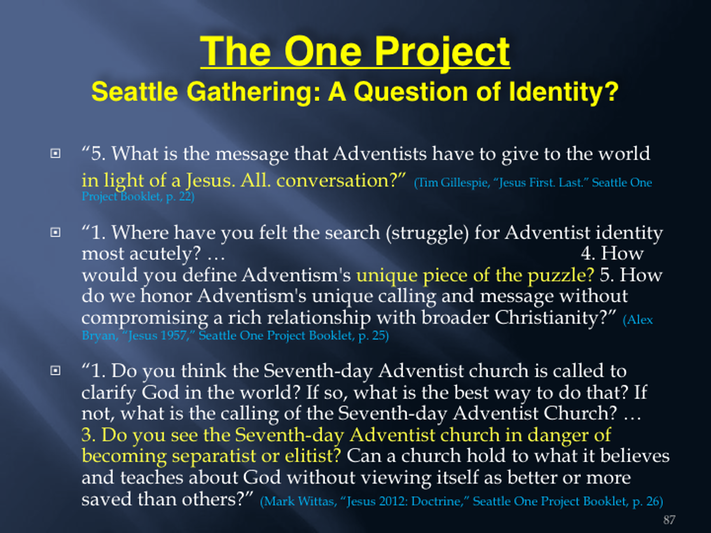
After all the presentations, Alex Bryan’s included, the table “conversations” would continue with discussions meant to help “Recalibrate” through guided questions made available in the gathering booklet. Many of these questions carried the same theme of questioning Adventism's identity as Alex Bryan and the other One Project presenters.
Although there are some aspects of these questions that are good to ask ourselves, in the context of the One Project, these questions seem to be leading toward an ecumenical theme and away from any Remnant identity.
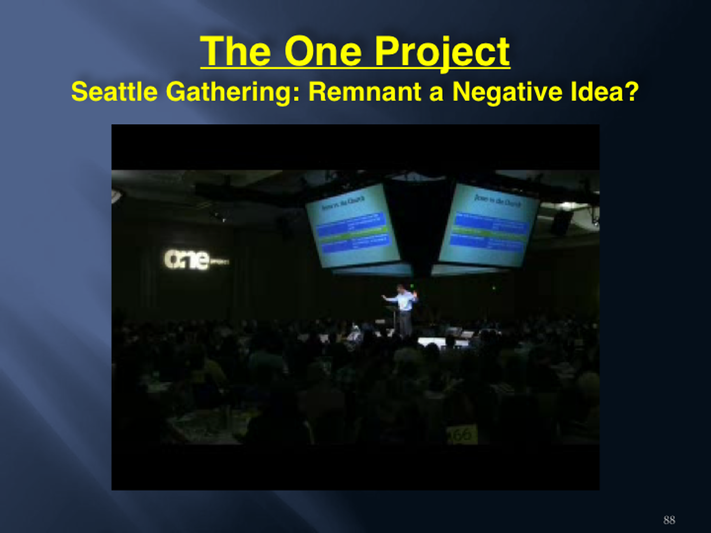
Along with a push to accept non-Adventist Emerging Church authors, and to move away from any concern about our identity, uniqueness or prophetic calling, there also seemed to be a very real antagonism against the idea of being the Remnant church. Almost without exception, the word was not used except in a negative light. (3:04 Minutes)
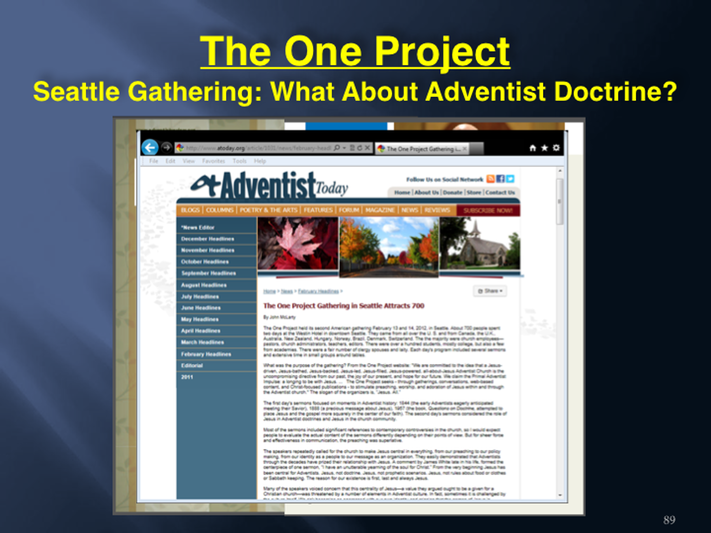
The negative feelings expressed toward the idea of the Remnant church also seemed to spill over into the area of Adventist doctrine or doctrines in general. A hint of this is seen in the March 15, 2012 Adventist Review , and more clearly in John McLarty’s article for Adventist Today. Both these articles shed further light on the overall theme of the presentations and the conversations that followed.
(Ansel Oliver, “’One Project’ Focuses on Adventists’ Relationship With Jesus,” Adventist Review, March 15, 2012, pp. 10-12)
(http://www.atoday.org/ article/1031/news/2012/ february-headlines/the-one-project-gathering-in-seattle-attracts-700)
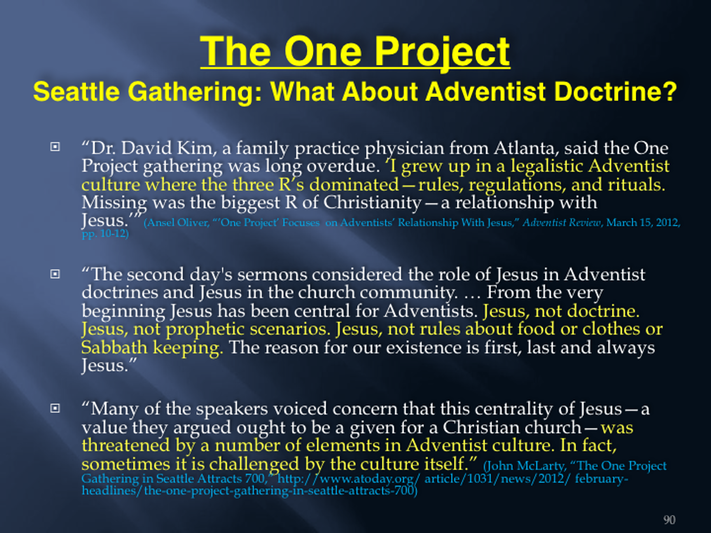
The negative feelings expressed toward the idea of the Remnant church also seemed to spill over into the area of Adventist doctrine or doctrines in general. A hint of this is seen in the March 15, 2012 Adventist Review , and more clearly in John McLarty’s article for Adventist Today. Both these articles shed further light on the overall theme of the presentations and the conversations that followed.
(NPUC Gleaner, April 2012, pp. 1, 22, 26)
(Ansel Oliver, “’One Project’ Focuses on Adventists’ Relationship With Jesus,” Adventist Review, March 15, 2012, pp. 10-12)
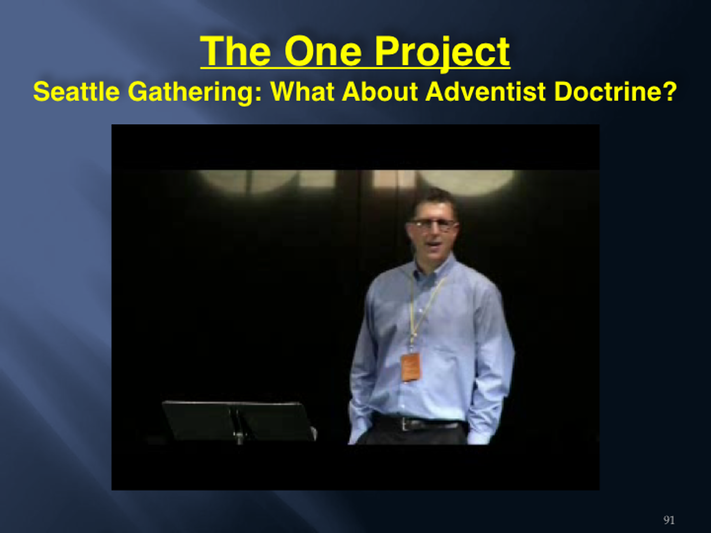
Mark Witas presentation was on doctrines. Although some good points were made some very questionable ones were made as well. Table conversations following some of the presentations took these concepts to a logical conclusion (see below). (4:15 Minutes)
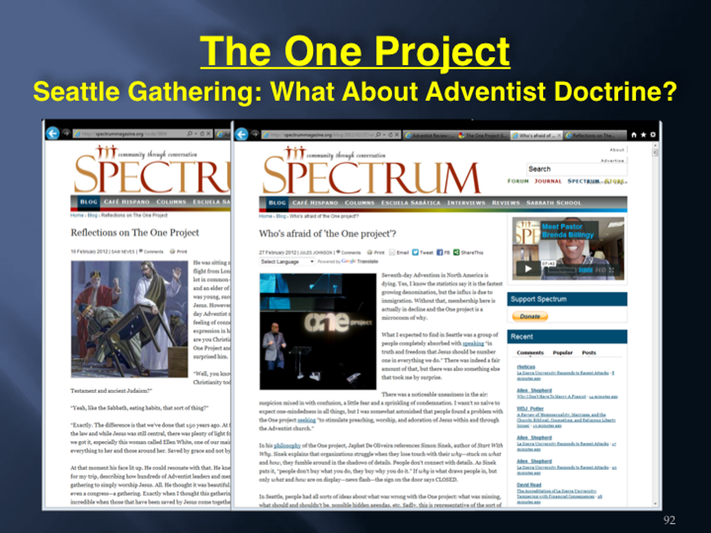
Table conversations following some of the presentations took concepts shared to a logical conclusion. Two articles in Spectrum revealed some of the thoughts of participants following Alex Bryan and Mark Witas’ presentations.
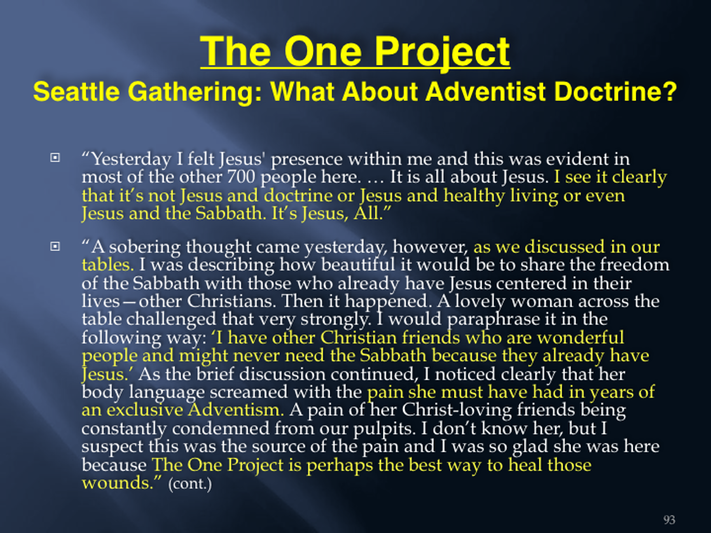
Table conversations following some of the presentations took concepts shared to a logical conclusion. Two articles in Spectrum revealed thought of participants following Alex Bryan and Mark Witas’ presentations.
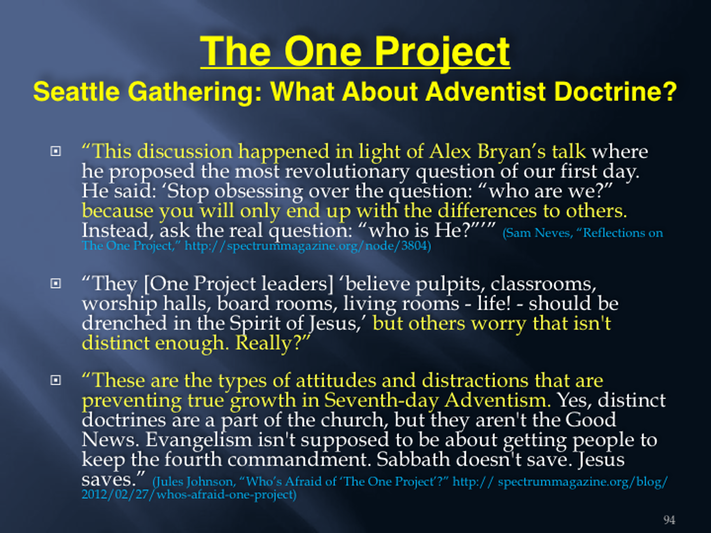
Table conversations following some of the presentations took concepts shared to a logical conclusion. Two articles in Spectrum revealed thought of participants following Alex Bryan and Mark Witas’ presentations.
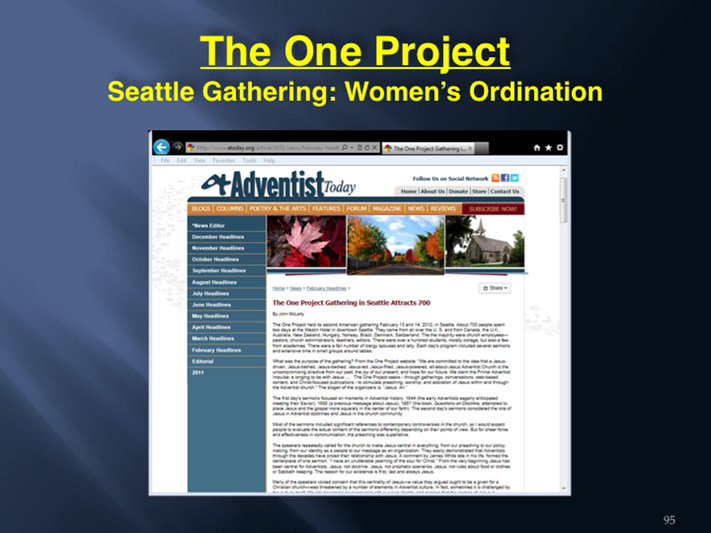
John McLarty brings out another hot topic which was discussed by many of the One Project presenters at the Seattle gathering—Women’s Ordination.
(http://www.atoday.org/ article/1031/news/2012/ february-headlines/the-one-project-gathering-in-seattle-attracts-700)
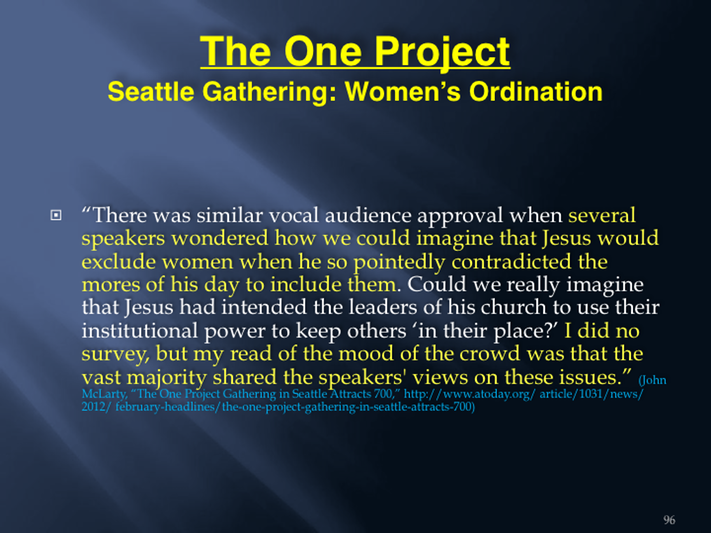
John McLarty brings out another hot topic which was discussed by many of the One Project presenters at the Seattle gathering—Women’s Ordination.
The problem is that the topic was really not discussed by going over the different views held within the Adventist church and the reasons why (something you would expect in a “conversation”). Instead there were pot shots taken at the Adventist Church for its historic stance which is seen as contrary to the mores of current society. Adventism is described as “exclusive,” as have policies not supported by Jesus. 17 year old Ellen White was even described as holding a position of “pastoral leadership.” Some appeared to expressed their feelings with anger. Other’s just matter of fact.
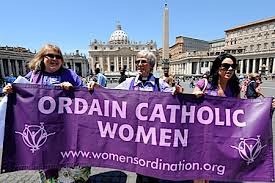
So who will be first? The Roman Catholic Church or the Seventh Day Adventist Church?
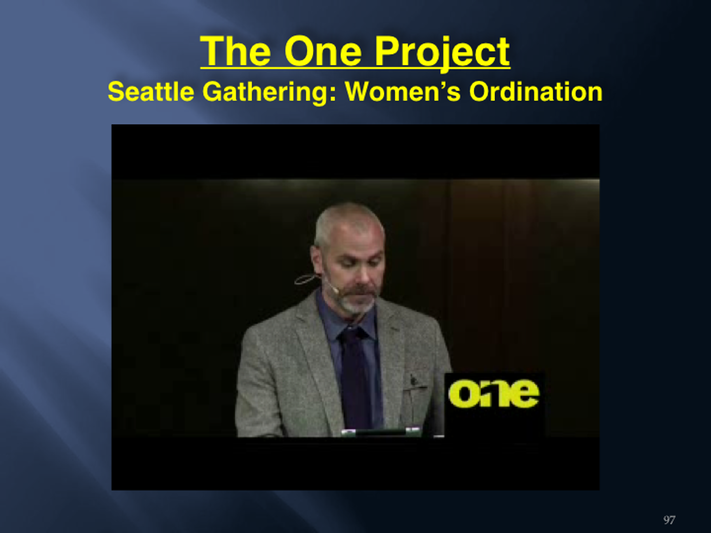
John McLarty (in the article above), brought out another hot topic which was discussed by many of the One Project presenters at the Seattle gathering—Women’s Ordination.
The problem is that the topic was really not discussed by going over the different views held within the Adventist church and the reasons why (something you would expect in a “conversation”). Instead there were pot shots taken at the Adventist Church for its historic stance which is seen as contrary to the mores of current society. Adventism is described as “exclusive,” as having policies not supported by Jesus. 17 year old Ellen White was even described as holding a position of “pastoral leadership.” Some speakers appeared to expressed their feelings with anger. Other’s just matter of fact. (4:15 minutes).
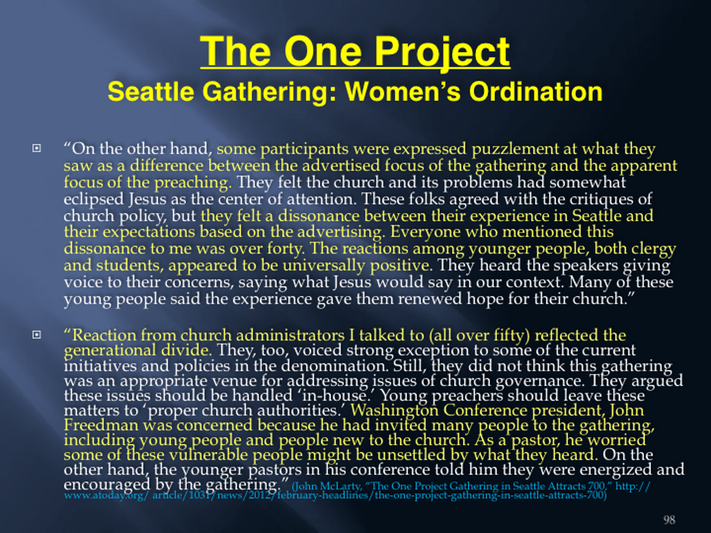
According to John McLarty, some participants at the Seattle gathering were puzzled over a discrepancy between what was advertised about the One Project (“A two day conversation about Jesus”), and what really took place (a two day venting about issues particularly of concern to progressive/liberal Adventists). McLarty’s take was that most everyone agreed with the views taken on issues, but some felt it was not the place to deal with them. He also suggested that it was only the older folks that had concerns and not the younger generation. This might shed some light on why the One Project is being geared toward young people on our Adventist campuses.
In regard to John Freedman, Washington Conference president, The NAD Gleaner article gave the impression that he was in full support of the entire One Project emphasis (see slide 13 above). The Adventist Today article, however, indicated that Freedman was not comfortable with how the Project had been misleading in its advertising.

John McLarty continues with the response of Alex Bryan to the concerns of some that making Women’s ordination the message of The One Project was misleading compared to the way the event was advertised. It is clear from Bryan’s response that he sees the One Project as a messenger to the Church with the message for this time.
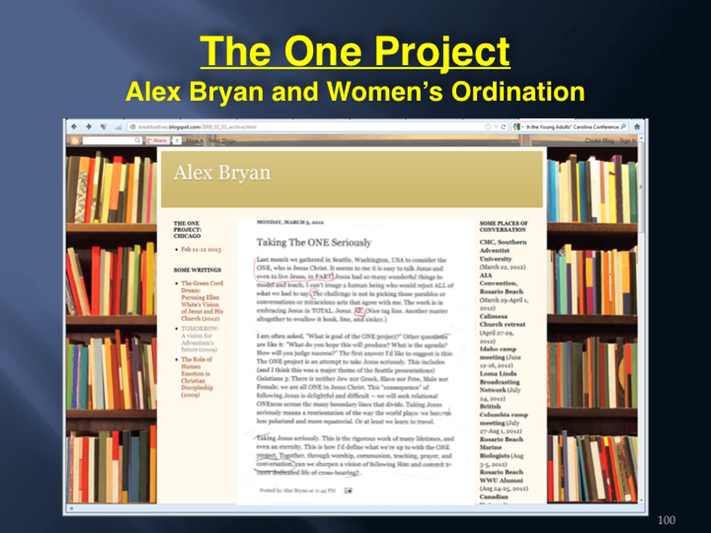
Alex Bryan also posted on his own personal blog his reflections of the Seattle gathering with similar thoughts. (this blog has since been removed and was scanned in here). The one subject that Alex highlights here as a “major theme of the Seattle presentations” was the issue of women’s ordination. Once again this is a totally different description of the gathering from that presented in the Churches official papers like the Adventist Review and Gleaner.
(http://breakfastfires.blogspot.com/2012/03/taking-one-seriously.html [no longer on the web])
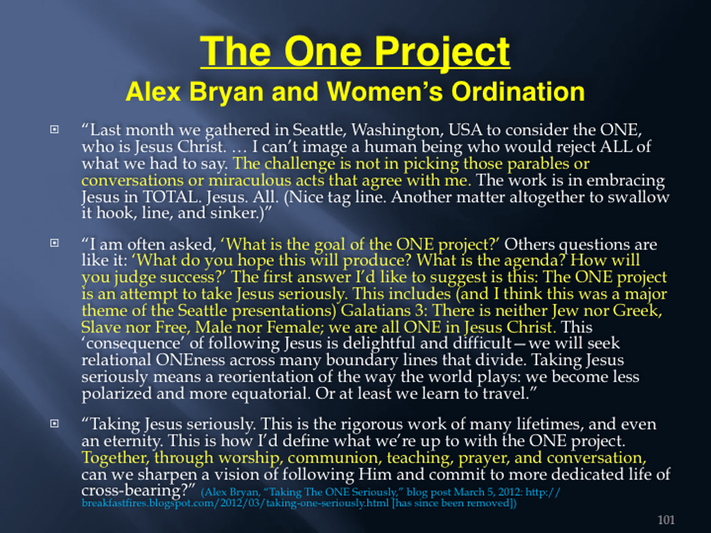
Alex Bryan also posted on his own personal blog his reflections of the Seattle gathering with similar thoughts. (this blog has since been removed and was scanned in here). The one subject that Alex highlights here as a “major theme of the Seattle presentations” was the issue of women’s ordination. Once again this is a totally different description of the gathering from that presented in the Churches official papers like the Adventist Review and Gleaner.
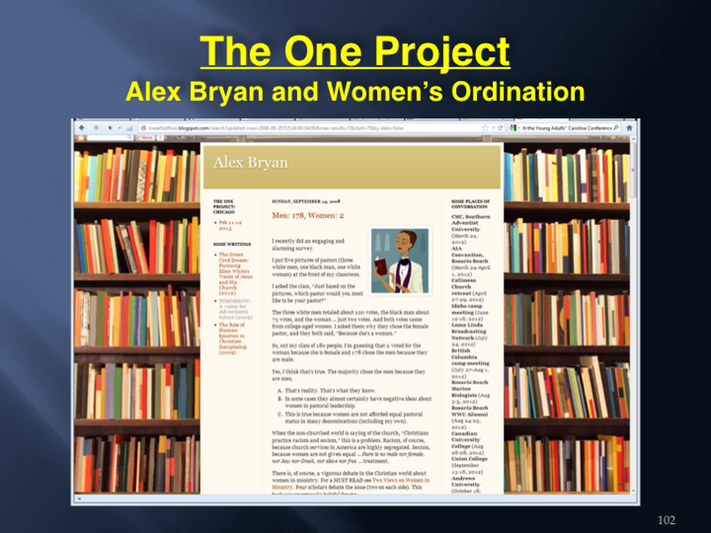
Alex Bryan has been pushing the issue of women’s “equality” and women’s ordination for some time. Back in 2008, less than a year after he returned to Adventist employment from his failed Church plant (see presentation 6), Alex did a survey in his class at Southern University, the results of which were alarming to him. He posted these results on his blog (which has since been removed), expressing how he feels Adventism needs to change.
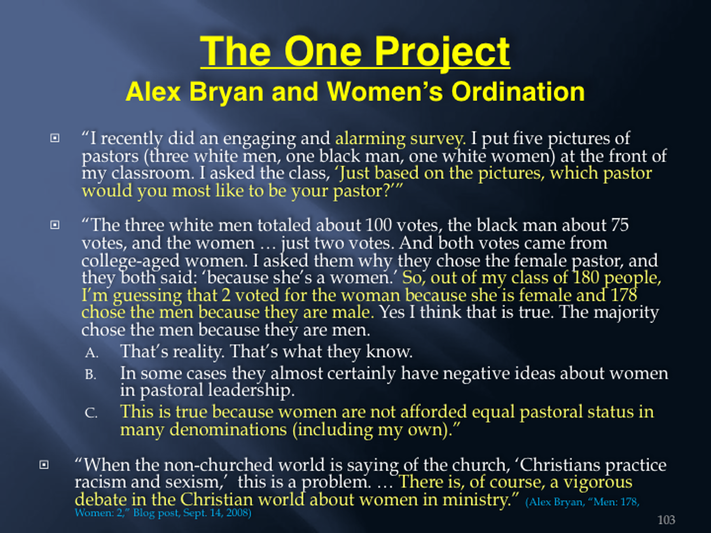
Alex Bryan has been pushing the issue of women’s “equality” and women’s ordination for some time. Back in 2008, less than a year after he returned to Adventist employment from his Church plant (see presentation 6), Alex did a survey in his class at Southern University, the results of which were alarming to him. He posted these results on his blog (since been removed), expressing how he feels Adventism needs to change. Why are some in Adventism trying to take on the same controversies found in the Christian world?
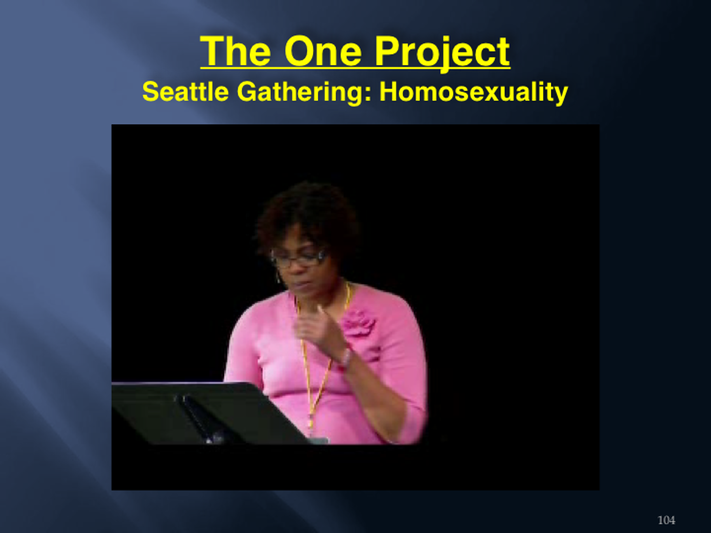
Closely related to the whole women’s ordination issue as found in the Christian world is the issue of homosexuality. This is because their arguments seem to be primarily based on their concepts of “equality”. There was also an attempt to make this subject prominent at the One Project by at least one of the speakers. (1:27 Minutes).
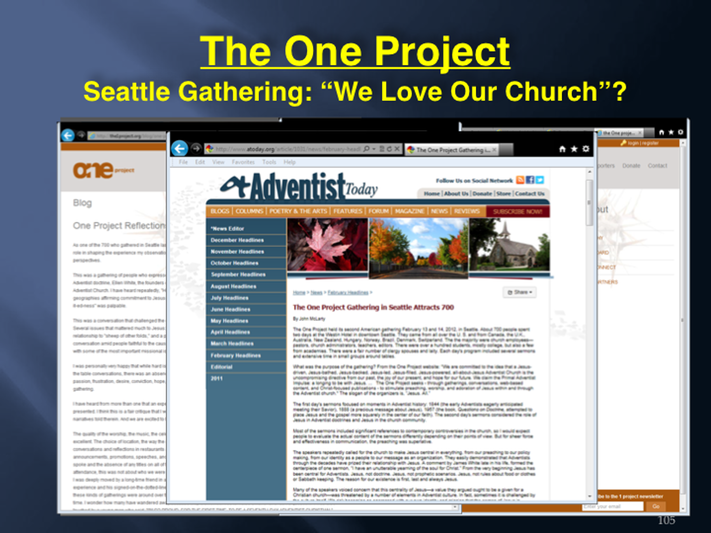
With all the above venting against the Church by the leaders of the One Project, there seemed to be both in print and during their presentations an almost over emphasis at times, assuring everyone that they really did have great love for the Adventist Church.
(Ansel Oliver, “’One Project’ Focuses on Adventists’ Relationship With Jesus,” Adventist Review, March 15, 2012, pp. 10-12)
(http://the1project.org/why.html)
(http://the1project.org/blog/one-project-reflections-by-alex.html)
(http://www.atoday.org/ article/1031/news/2012/ february-headlines/the-one-project-gathering-in-seattle-attracts-700)
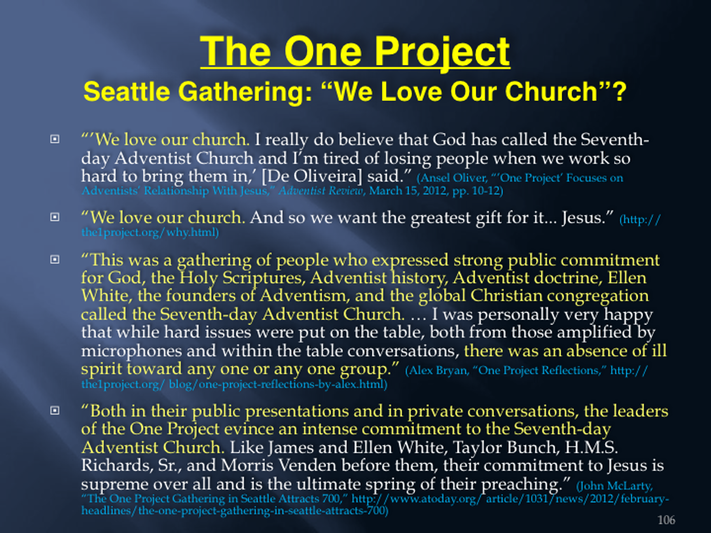
With all the above venting against the Church by the leaders of the One Project, there seemed to be both in print and during their presentations an almost over emphasis at times, assuring everyone that they really did have great love for the Adventist Church.
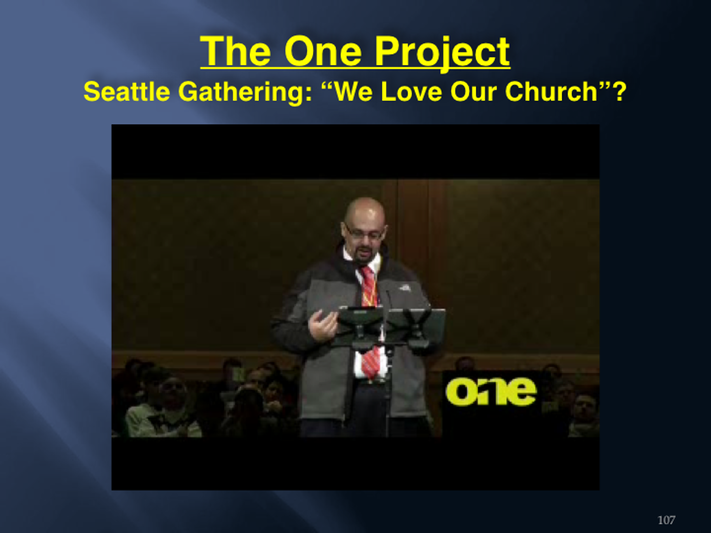
With all the above venting against the Church by the leaders of the One Project, there seemed to be both in print and during their presentations an almost over emphasis at times, assuring everyone that they really did have great love for the Adventist Church.
Yet it seems clear that there is a lot in Adventism they do not love, and that they don’t see Adventism in “traditional terms”. Thus they love an Adventism which they are seeking to create? (2:54 Minutes).
The second video clip of Eddie Hypolite was taken from a talk titled "Worship Life" and was delivered at the Andrews University Music and Worship conference, March 24-26, 2011 after the first One Project in Atlanta (see: http://vimeo.com/24295865 )
Are we really just the product of our environment? And should that be the driving force behind what our mission as a Church really looks like?
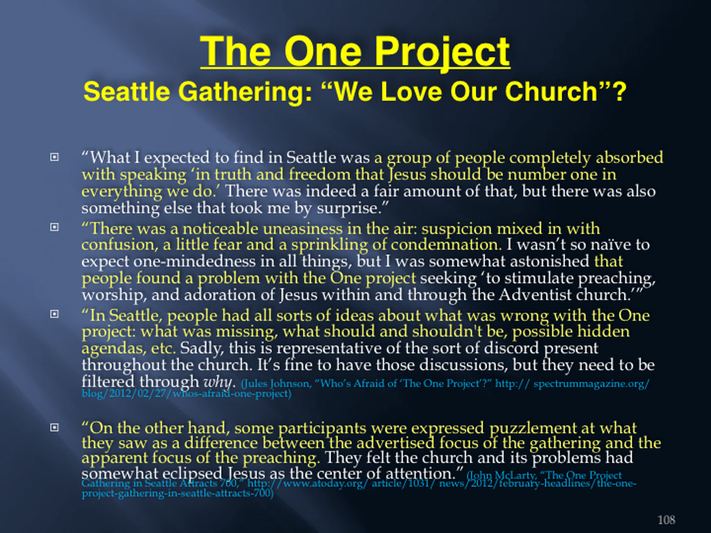
Yet even with all the assurance of love for the Church by One Project presenters, there still must have been at least some with serious questions about the gathering. Jules Johnson from the Spectrum perspective seemed to think that those with concerns were unjustified. John McLarty of Adventist Today was more congenial but chalked it up to the older generation’s concerns.
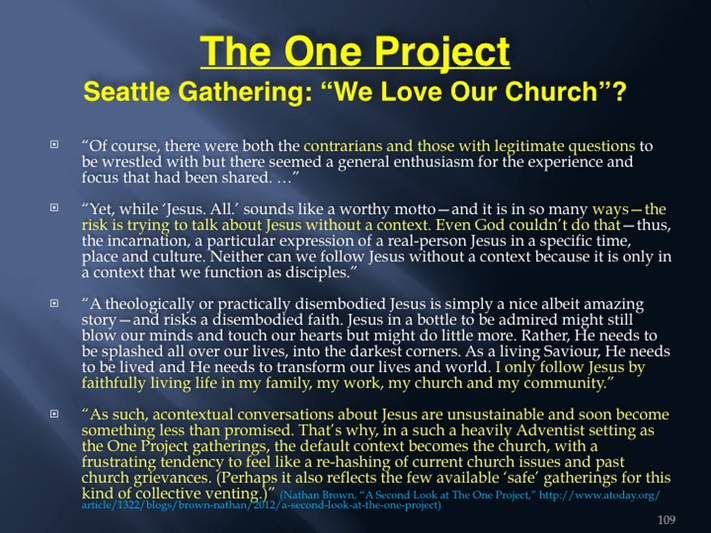
Nathan Brown, also from Adventist Today perspective and overall supportive of the Project, after attending the Seattle gathering and the Sydney gathering recognized not only that some had concerns, but he also suggested there was a possible reason for such.
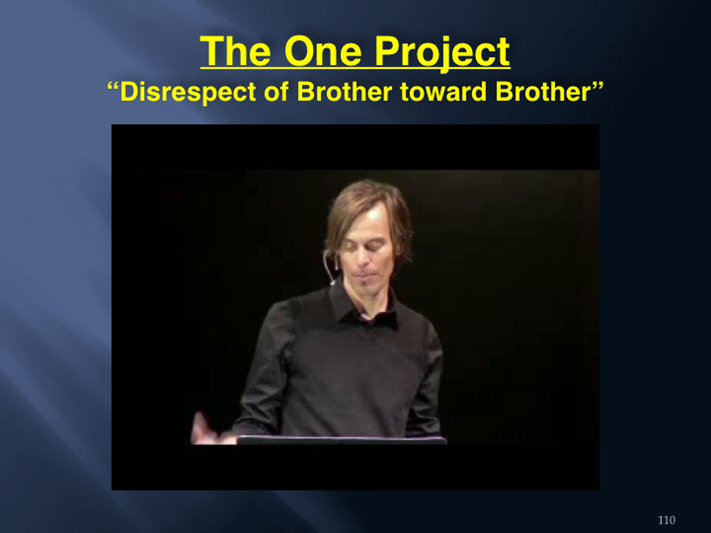
But while the Seattle gathering was so clearly described as a place that “Jesus followers” could come and “vent” about the problems they feel the Church has, expressions of concern about the One Project did not appear to be taken well. Unfortunately many of the concerns seemed to have been blown off as having no validity (see McLarty’s Adventist Today article). Other concerns were seen only as an attack on the Project and their wanting to make Jesus. All.
Sam Leonor, while going over 1888 history, mentioned the disrespect that had been shown of “brother toward brother” during that time. He made a tearful application to our day: “when we disagree on the things that seem fundamental to us, why to we treat each other this way?” Although a very good question to ask ourselves today, it seems incredible that such a question could be asked in light of some of the things said at the Seattle gathering, and the way in which they were stated. But his is not new. There seems to be a blindness among most Progressive Adventists to the hurtful things said and done over the past 40 years through Spectrum Magazine and through 20 years of Adventist Today, and the continued disunity and havoc brought upon Adventism through that movement. Unfortunately most of this has been spread through our college and university campuses. (1:32 Minutes)
Webmaster note: A couple young people recently attended the 2014 One Project in Seattle and this is their report and assessment: One Project: present or emergent truth?
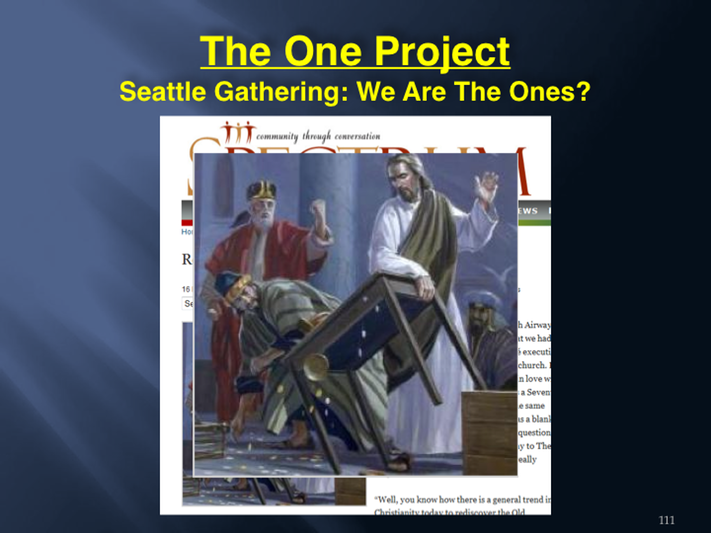
While a tearful call was made from a Project leader to treat each other with kindness, the One Project has seemed to place itself in a certain context which does little to encourage such. In a Spectrum article about the One Project, the picture used to illustrate the purpose of the Project is of Jesus cleansing the temple. What is this stating about the One Project—the “Jesus followers”—and the church leadership which they are often in cahoots with? One should remember, however, that Jesus cleansed the temple from Priests and rulers, which were made up of more Sadducees than Pharisees.
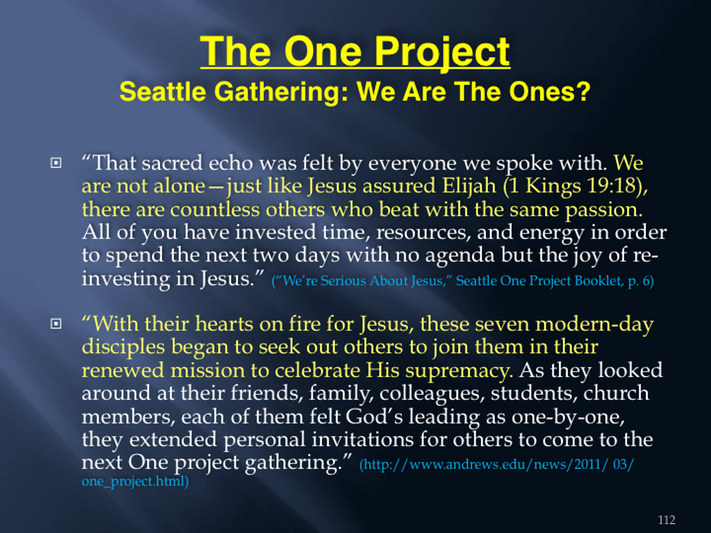
Many similar examples could be given of articles written about the One Project and it’s leaders which seem to place them on a pedestal above other Adventists—those who have all the answers for what ails Adventism. In the Seattle gathering booklet they compare themselves to Elijah, assuring participants that there are others (7000) like them (who have not bowed the knee to baal?). Andrews University News compared the seven initial project leaders to Jesus disciples. Of course, where does all of this put anyone else who might question some of the Project’s agendas?
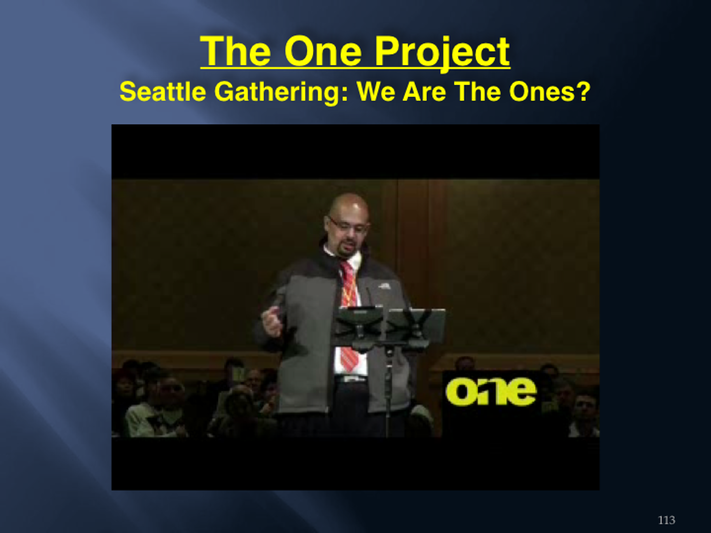
Similar claims where stated at the Seattle gathering. The Project attendees were compared to Gideon's band of 300 (or 693). While reviewing Adventist history there seemed to be a not so subtle identification of the Project movement with Jones, Waggoner and Ellen White, and the current General Conference and Church organization with the law oriented, legalistic Butler and Smith. Thus the Project is “better informed” and wanting to move beyond the apparent failings of the Church current condition. (3:44 Minutes).
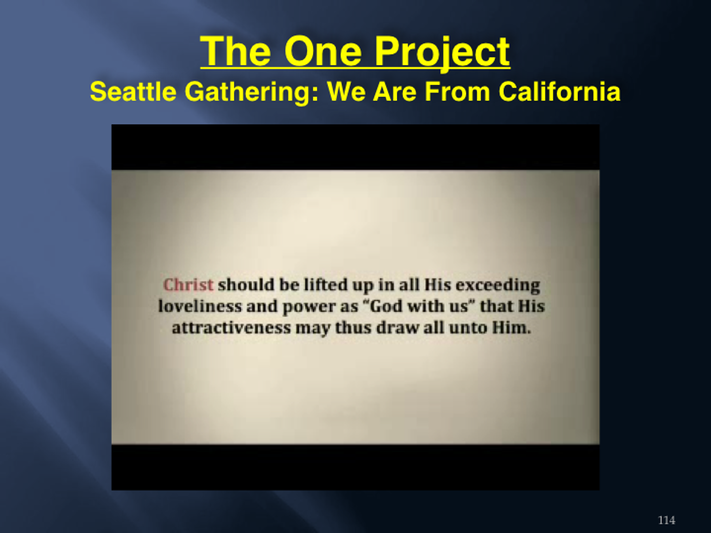
At the same time there seemed to be a lot of jesting about “California.” Although sometimes stated in the context of 1888 and Jones and Waggoner, there was an apparent identification with the element of the long standing challenge from Progressive Adventism which comes out of California (Desmond Ford, PUC, Loma Linda, La Sierra, Spectrum Magazine, Adventist Today, etc.?). (1:08 Minutes)
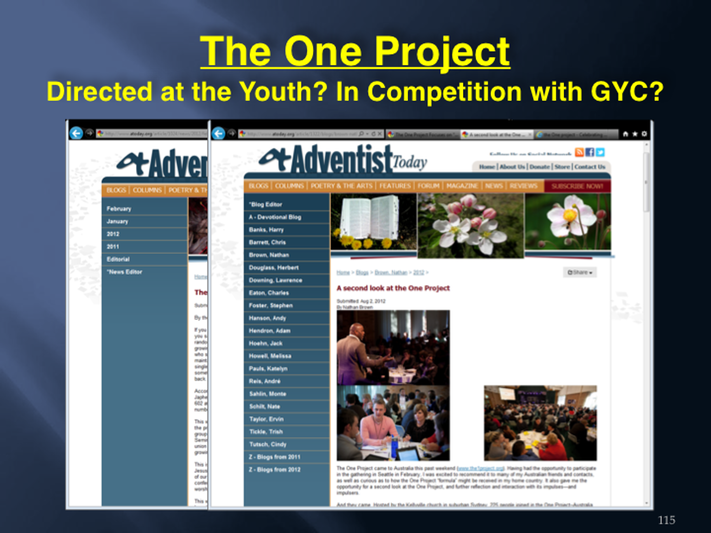
In the early days of The One Project, the claims made by the Project leaders were that it was a movement directed toward the entire church. This seems to be the case with the Seattle gathering where a large number of NAD pastors and leadership were invited to attend along with young people from our university campuses. However, as time has passed it has seemed more plausible that the movement is primarily aimed at Adventist young people and is being promoted through our Universities. The fact is that most of the Project leaders are located on University campuses.
At the same time it has also been more than apparent, particularly on the progressive web sites of Adventist Today and Spectrum Magazine, that The One Project is in fact a rivalry against the GYC youth movement.
(http://www.andrews.edu/news/2011/03/one_project.html)
(http://www.atoday.org/article/1024/news/2012/february-headlines/the-one-project-focuses-on-the-one-at-the-center-of-adventist-faith)
(http://www.atoday.org/article/1322/blogs/brown-nathan/2012/a-second-look-at-the-one-project)
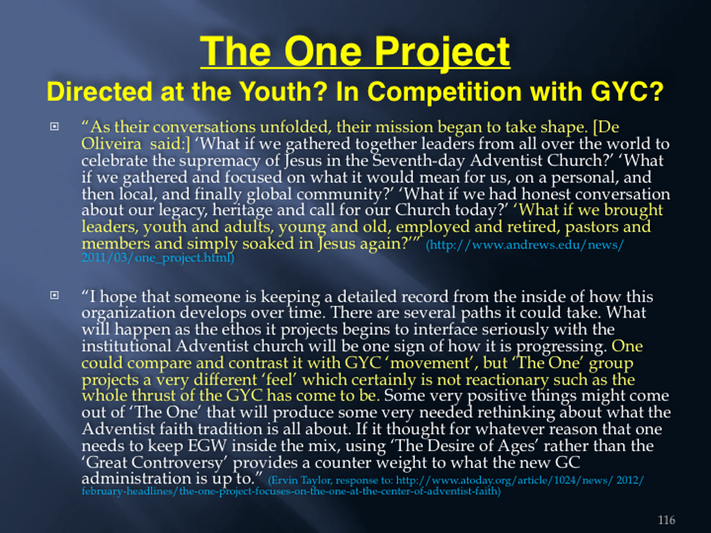
In the early days of The One Project, the claims made by the Project leaders were that it was a movement directed toward the entire church. This seems to be the case with the Seattle gathering where a large number of NAD pastors and leadership were invited to attend along with young people from our university campuses. However, as time has passed it has seemed more plausible that the movement is primarily aimed at Adventist young people and is being promoted through our Universities. The fact is that most of the Project leaders are located on University campuses.
At the same time it has also been more than apparent, particularly on the progressive web sites of Adventist Today and Spectrum Magazine, that The One Project is in fact a rivalry against the GYC youth movement.
Ervin Taylor, Ph.D., is professor emeritus of anthropology at the University of California, Riverside. He is also a long-time supporter, executive publisher, and contributor to the “progressive” journal Adventist Today. He has also been very active in supporting La Sierra University’s teaching of evolution as fact. Taylor has also been very outspoken against Ellen White.
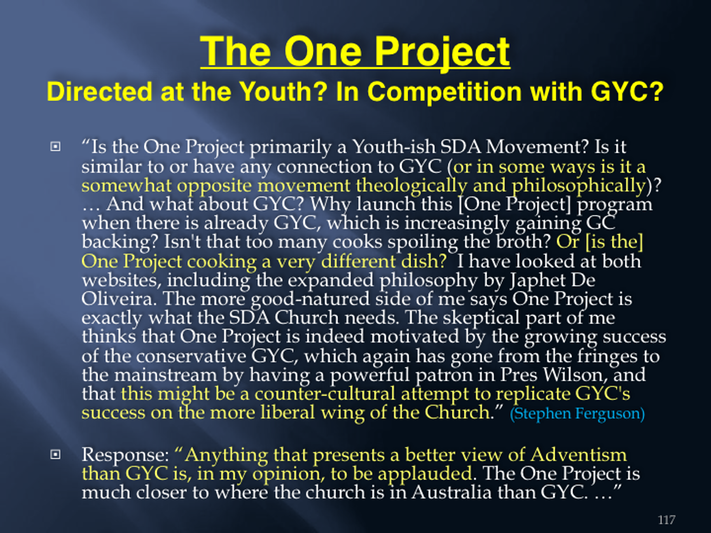
Although the stated goals lead us to believe the Project is directed toward youth, the first gatherings have invited many in NAD, SPD, and European leadership to come and take part. Yet some have asked rather searching questions, like the following taken from comments on an Adventist Today blog post following an article on The One Project’s meeting in Australia in July 2012.
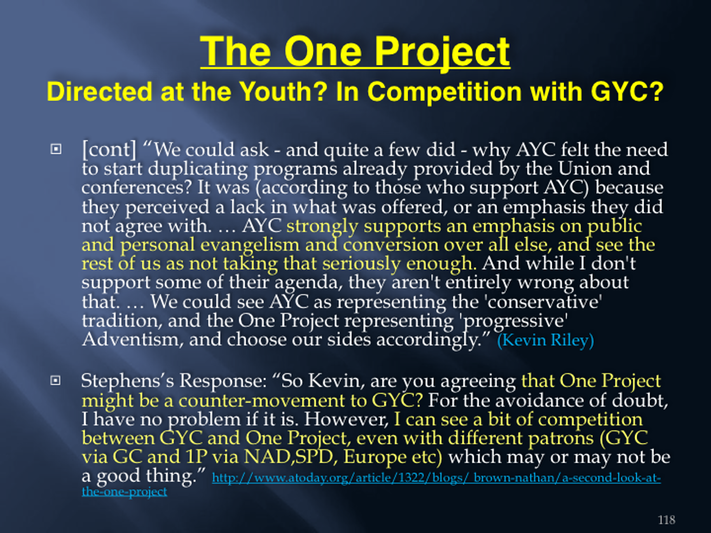
AYC= Australian Youth Congress. Although the stated goals lead us to believe the Project is directed toward youth, the first gatherings have invited many in NAD, SPD, and European leadership to come and take part. Yet some have asked rather searching questions, like the following taken from comments on an Adventist Today blog post following an article on The One Project’s meeting in Australia in July 2012.
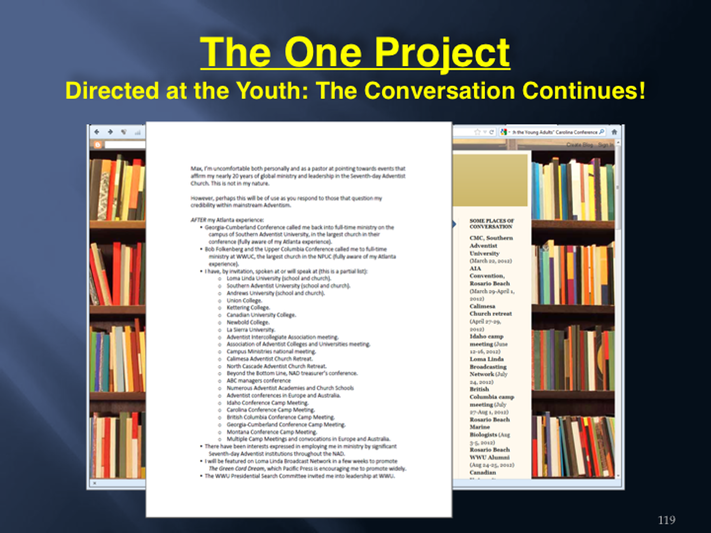
It would appear that the Project’s agendas is to take the One Project across the country to our University campuses, and not just share at the yearly gatherings. Alex Bryan had posted on his blog all the places he was being asked to speak, and listed them under the heading of “Some Places of Conversation” (this blog format has since been changed and the list removed). Many of these places of conversation are taking place at Adventist Colleges and Universities or in other setting directed toward young Adventists.
Alex made a similar list in a letter to Max Torkelson, North Pacific Union President, sometime in July, 2012, following his failure to be elected at Walla Walla University President.
(breakfastfires.blogspot.com/2009_02_03_archives.html)
(Alex Bryan to Max Torkelson, July 2012)
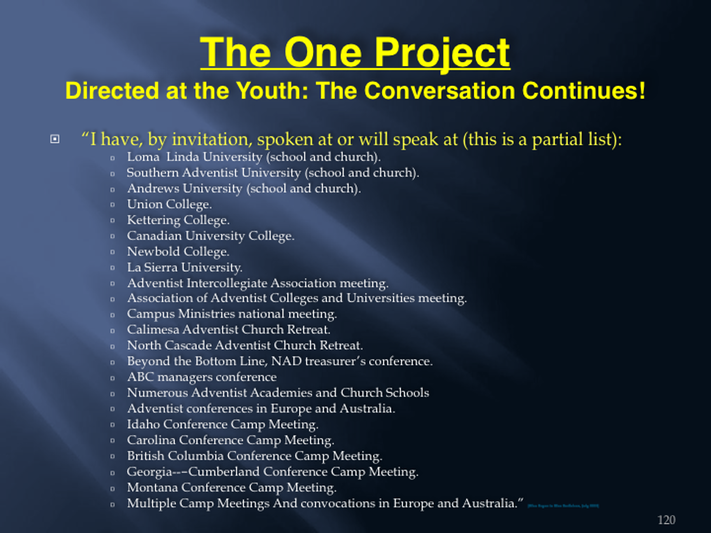
It would appear that the Project’s agendas is to take the One Project across the country to our University campuses, and not just share at the yearly gatherings. Alex Bryan had posted on his blog all the places he was being asked to speak, and listed them under the heading of “Some Places of Conversation” (this blog format has since been changed and the list removed). Many of these places of conversation are taking place at Adventist Colleges and Universities or in other setting directed toward young Adventists.
Alex made a similar list in a letter to Max Torkelson, North Pacific Union President, sometime in July, 2012, following his failure to be elected at Walla Walla University President.
(Alex Bryan to Max Torkelson, July 2012)
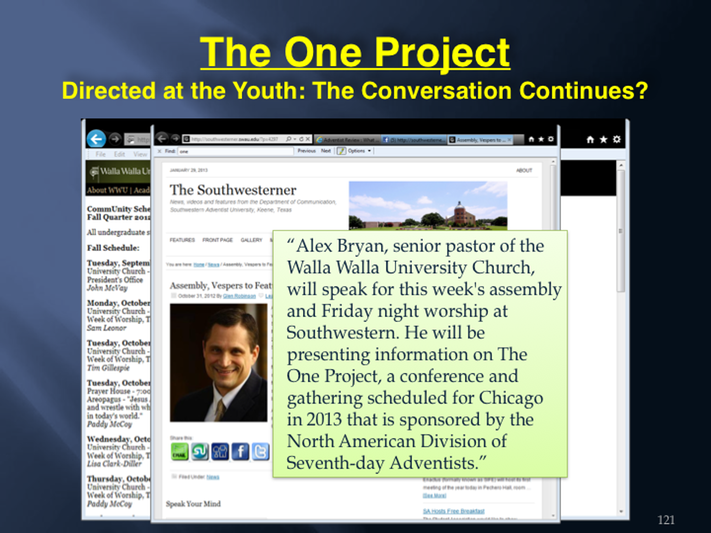
Alex invited the One Project team to Walla Walla University to give their Fall 2012 Week of Worship. The theme was Jesus. All. It would seem that even if young people don’t attend The One Project gatherings, the same “conversation” will be brought to the whole student body at our Universities.
When Alex gave his talks at Southwestern Adventist University in November 2012, his topic was again The One Project. Of course we would not suggest that everything presented at the One Project gatherings are wrong, or that the Adventist church has no need to lift up Jesus more, but we would question whether the One Project has a true sense of what ails us as a people and the correct remedies as found in Revelation 3 .
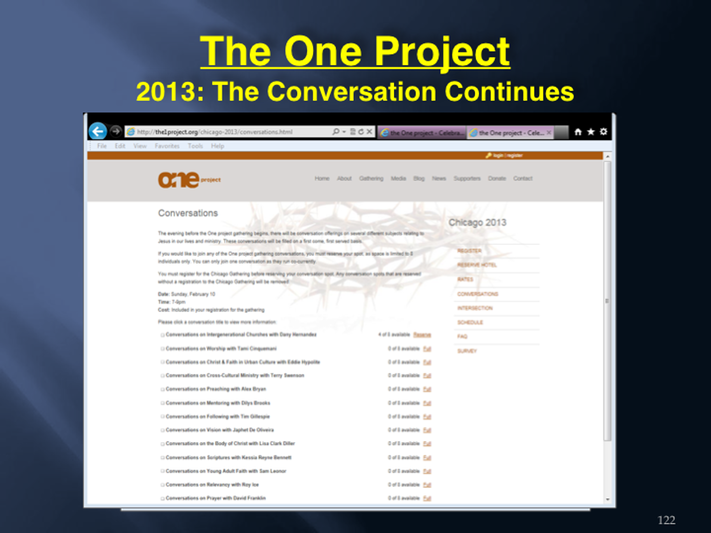
The Project website identifies “conversations” as one of the avenues of spreading the Project’s ideas through Adventism. More forms of “conversations” are planned for the Chicago 2013 gathering. One form is where only 8 participants will take part in “conversations” directed by each Project leader. While the descriptions of the topics may be relevant to talk about, what direction are the Project leaders leaning toward through these various “conversations”?
(http://the1project.org/why.html)
(http://the1project.org/chicago-2013/conversations.html)
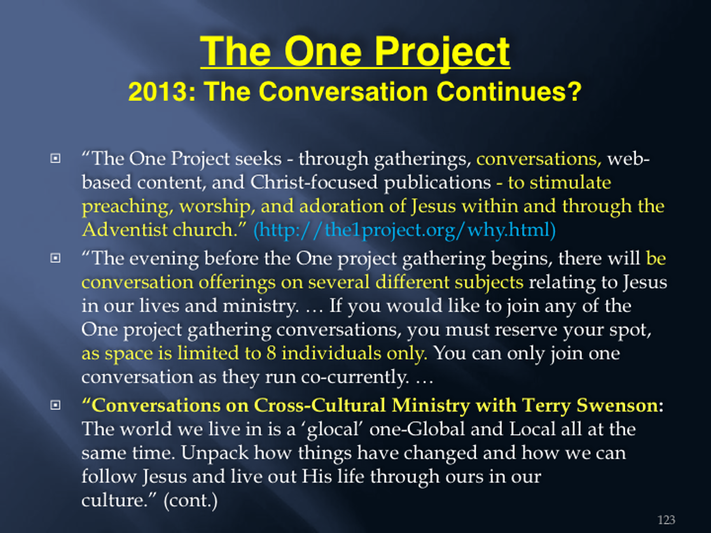
The Project website identifies “conversations” as one of the avenues of spreading the Project’s ideas through Adventism. More forms of “conversations” are planned for the Chicago 2013 gathering. One form is where only 8 participants will take part in “conversations” directed by each Project leader. While the descriptions of the topics may be relevant to talk about, what direction are the Project leaders leaning toward through these various “conversations”?
Obviously the presenter’s past experience will effect the way their topic is presented. (see presentations 5 – 9)
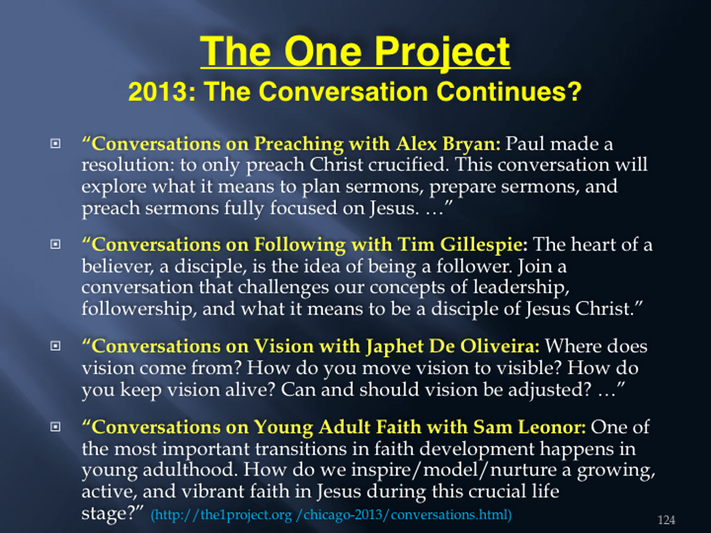
The Project website identifies “conversations” as one of the avenues of spreading the Project’s ideas through Adventism. More forms of “conversations” are planned for the Chicago 2013 gathering. One form is where only 8 participants will take part in “conversations” directed by each Project leader. While the descriptions of the topics may be relevant to talk about, what direction are the Project leaders leaning toward through these various “conversations”?
Obviously the presenter’s past experience will effect the way their topic is presented. (see presentations 5 – 9)

The Seattle 2014 Gathering also plans to have for the first time “carefully selected speakers from other Christian traditions” share about “the One.”
From September 2013 One Project email.
http://theoneproject.createsend1.com/t/ViewEmail/r/1CE54BA9A69444AD2540EF23F30FEDED/CF4818127AA2AC3D405DC10595964AA8
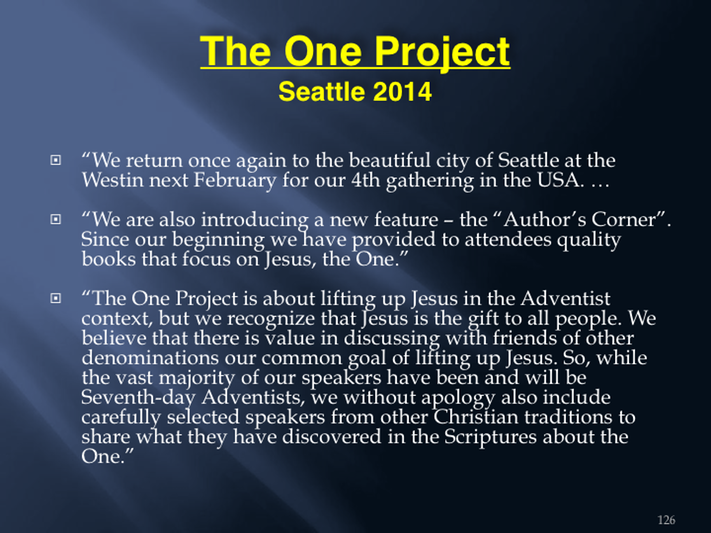
The Seattle 2014 Gathering also plans to have for the first time “carefully selected speakers from other Christian traditions” share about “the One.”
From September 2013 One Project email.
http://theoneproject.createsend1.com/t/ViewEmail/r/1CE54BA9A69444AD2540EF23F30FEDED/CF4818127AA2AC3D405DC10595964AA8
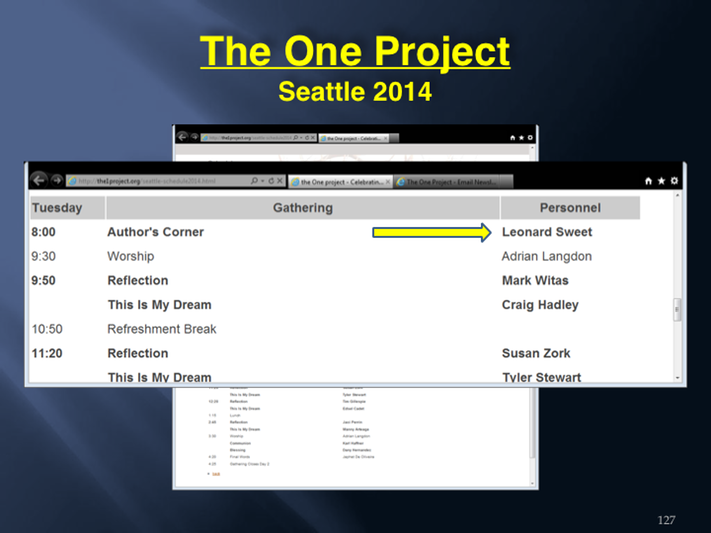
The Seattle 2014 Gathering also plans to have for the first time “carefully selected speakers from other Christian traditions” share about “the One.” For this 2014 gathering none other than Leonard Sweet will be present to share from his “Christian Tradition” which is steeped in mysticism and pantheism. The One Project in a few short years is truly Emerging.
ttp://the1project.org/seattle-schedule2014.html
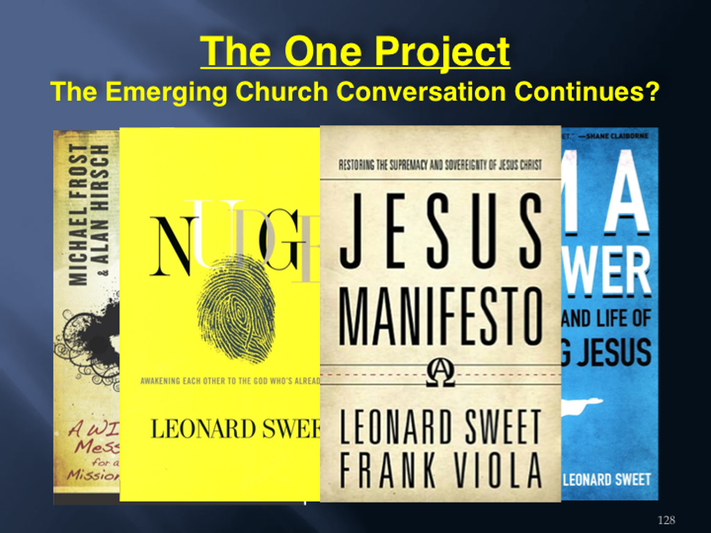
But how will the “conversations” continue in the future? Will there still be a reliance on Emerging Church books and their philosophy in the future One Project gatherings? Will the leaders who have all been heavily influenced by these Emerging Church concepts continue to move toward a “New Reformation” in Adventism? Will this move really be in the right direction or toward the ecumenical Evangelical world?
For more information: ReJesus: A Wild Messiah for a Missional Church, by Michael Frost and Alan Hirsch (see presentation 5); The Next Christians: The Good News About the End of Christian America (2010), by Gabe Lyons (see presentation 5); Simply Jesus: A New Vision of Who He Was, What He Did, and Why He Matters (2006), by N. T. Wright (see presentation 6); I Am A Follower: The Way, Truth and Life of Following Jesus, (Jan. 2012), by Leonard Sweet (see presentation 4). Notice: “Leonard Sweet is a theological poet.”—Shane Claiborne. (on cover) “Its never been about leading”. (on cover at bottom); Nudge: Awakening Each Other to the God Who’s Already There (2010), by Leonard Sweet (see Presentation 4, and 8); Jesus Manifesto: Restoring the Supremacy and Sovereignty of Jesus Christ, (2010), by Leonard Sweet and Frank Viola (see presentations 3, 6 and 7).
(http://www.amazon.com/ReJesus-Wild-Messiah-Missional-Church/product-reviews)
(http://www.amazon.com/The-Next-Christians-Christian-America/product-reviews/)
(http://www.amazon.com/Simply-Jesus-Vision-What-Matters/dp/0062084399)
(http://www.amazon.com/Am-Follower-Truth-Following-Jesus/product-reviews/)
(http://apprising.org/2010/09/13/giving-leonard-sweet-a-nudge/)
(http://www.amazon.com/ Jesus-Manifesto-Restoring-Supremacy-Sovereignty/ product-reviews)
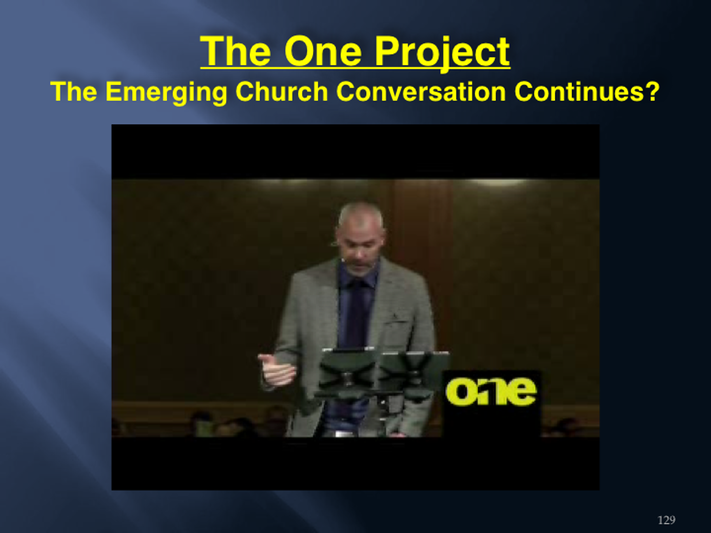
But how will the “conversations” continue in the future? Will there still be a reliance on Emerging Church books and philosophy in the future One Project gatherings? Will the leaders who have all been heavily influenced by these Emerging Church concepts continue to move toward a “New Reformation” in Adventism? Will this move really be in the right direction or toward the ecumenical Evangelical world?
The One Project in Seattle gave many examples of Emerging Church “talk” during the presentations. There was a lot of emphasis on a “new conversation” that needed to come into Adventism. Adventism’s unique calling was downed played while all where called “to be followers,” a reference to Leonard Sweet’s book. The thought that Jesus is at work in all of Christianity, although true in a certain sense, when presented in the light of Emerging Church concepts seems to be a move toward an ecumenical idea. Christ “in” everyone, is a thought very prominent in Leonard Sweet’s writings but also panentheistic. “Recalibration,” etc., is another example of Emerging Church lingo. This is just some of the many examples: (4:00 Minutes).
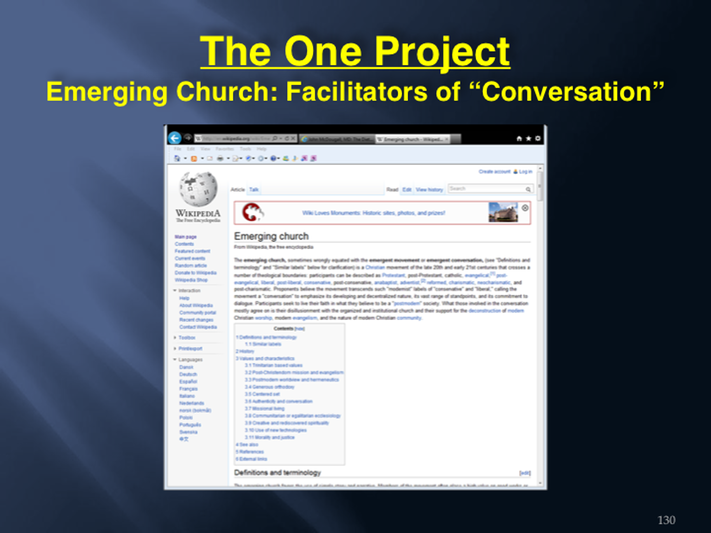
As we close this series on the Emerging Church and The One Project, we need to review how the “conversation” has been used by the Emerging Church movement over the past twenty years (next 5 slides). Then we need to ask ourselves if the One Project, lead by many who have been immersed in the Emerging Church movement (see presentations 5-9), are leading One Project participants into similar “conversations” based on these concepts?
As a review let us look at what Wikipedia has listed about the “Emerging Church” and “conversations” (this is taken from presentation 1).

As a review let us look at what Wikipedia has listed about the “Emerging Church” and “conversations” (this is taken from presentation 1). Is there any similarities between what is taking place in the Emerging Church movement and how the One Project gatherings are being presented?
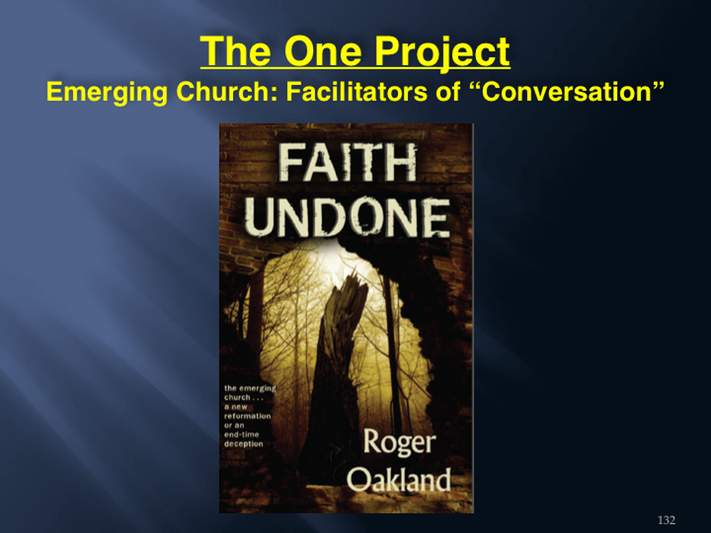
Roger Oakland has also dealt with this aspect of the Emerging Church in his book, Faith Undone: The Emerging Church … A New Reformation or an End-time Deception (2007)
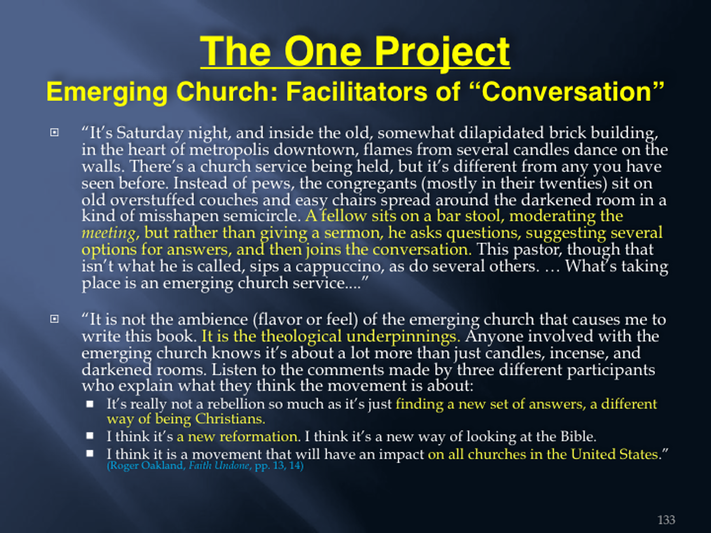
Roger Oakland has also dealt with this aspect of the Emerging Church in his book, Faith Undone: The Emerging Church … A New Reformation or an End-time Deception (2007)
In his introduction to the book Roger Oakland expresses the reasons why he took the time to write it. It was the theological issues of the “new reformation.” But notice how the movement is couched in “conversations.” It’s not necessarily the format of the gathering but the underlying theology that is driving it which should be of concern.
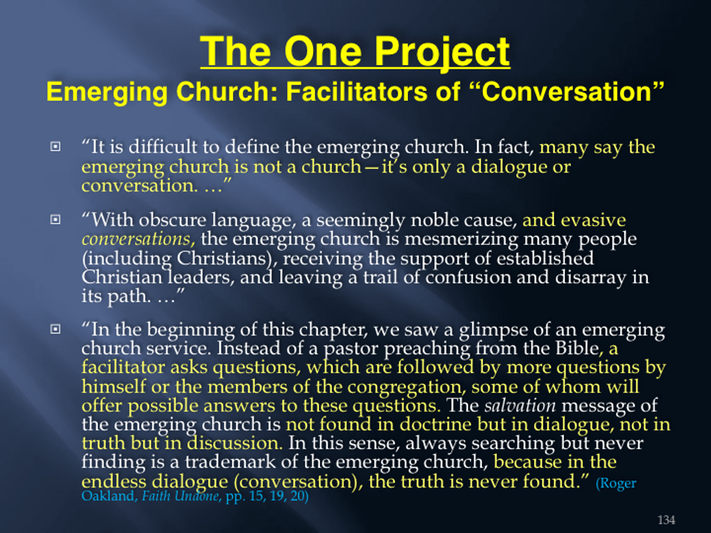
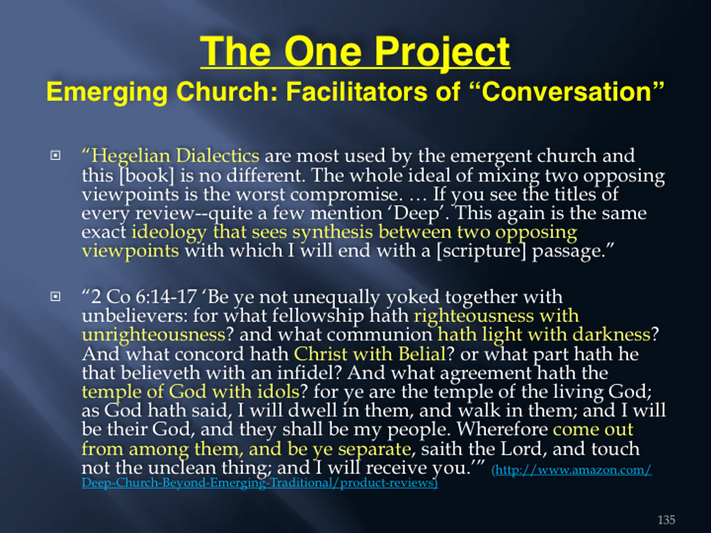
(Review) But if the One Project is a mixture of ideas from the Emerging Church along with Adventism, what will be the end result?
Notice how “dialogue” and “Conversation” fit into this idea of “Hegelian dialectic”. The Christian church is being told over and over that they have a problem. The Emerging Church claimed to be the solution which brought about conflict. Now books pointing to a third way. The point being that seeking a compromise between traditional church and emerging church, may in fact be actually another way of putting aside the created conflict to take a few more steps in an already intended direction. The Bible makes it clear that there is no mixture of truth and error. Its black and white. Yes, we are to seek how we might reach people in the world, but we are not to become in anyway like the world.
The Hegelian dialectic is the framework for guiding our thoughts and actions into conflicts that lead us to a predetermined solution. http://www.crossroad.to/articles2/05/dialectic.htm
Dialectic (also dialectics and the dialectical method) is a method of argument for resolving disagreement that has been central to Indian and European philosophy since antiquity. The word dialectic originated in ancient Greece, and was made popular by Plato in the Socratic dialogues. The dialectical method is dialogue between two or more people holding different points of view about a subject, who wish to establish the truth of the matter by dialogue, with reasoned arguments.[1] Dialectics is different from debate, wherein the debaters are committed to their points of view, and mean to win the debate, either by persuading the opponent, proving their argument correct, or proving the opponent's argument incorrect – thus, either a judge or a jury must decide who wins the debate. Dialectics is also different from rhetoric, wherein the speaker uses logos, pathos, or ethos to persuade listeners to take their side of the argument. …
Hegelian dialectic, usually presented in a threefold manner, was stated by Heinrich Moritz Chalybäus as comprising three dialectical stages of development: a thesis, giving rise to its reaction, an antithesis, which contradicts or negates the thesis, and the tension between the two being resolved by means of a synthesis. (http://en.wikipedia.org/wiki/Dialectic)
Basically, Hegel believed that history unfolds as a thesis is countered by an antithesis. Through persuasive argument, a synthesis is created which becomes a new thesis, countered by – you guessed it – an antithesis. This process continues until an “absolute idea” is created for which an antithesis cannot be formulated. Thus, society continues to progress toward’s Hegel’s ideal state. …
According to the late Dr. Antony C. Sutton, Hegelian dialectic has also been used as a tactic to create war and revolution – “managed conflict” – throughout the world.7 Dr. Sutton suggested that this Marxist philosophy was at work in 1917′s Bolshevik Revolution, the rise of Hitler in pre-WWII Germany, and WWII. (http://www.believeallthings.com/1481/hegelian-dialectic/)
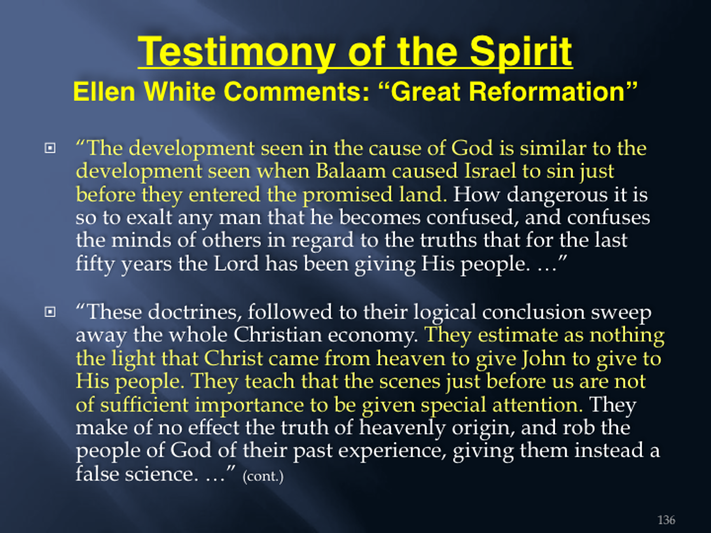
God has warned us in the past of a New Reformation movement that would seek to change Adventism. Written in the early 1900s, and in the context of Kellogg and the issue pantheism (alpha).
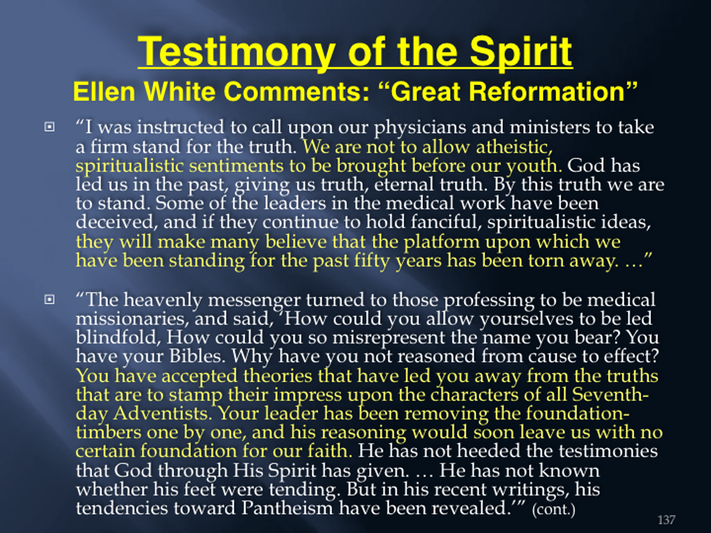
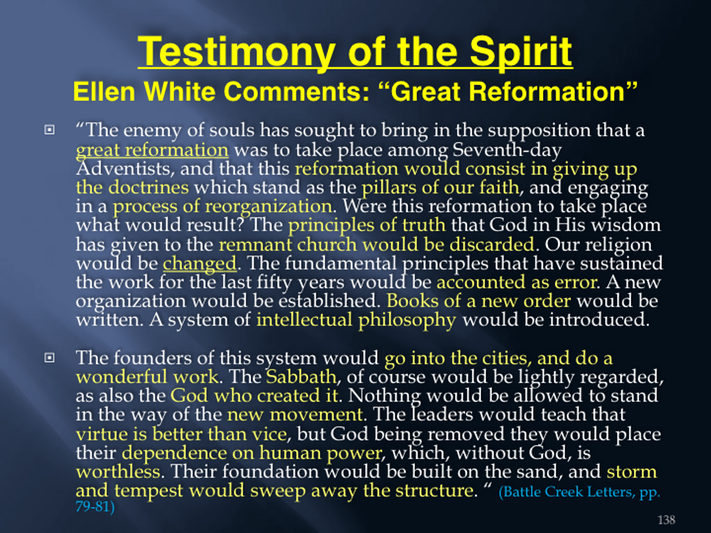
God has warned us in the past of a New Reformation movement that would seek to change Adventism. Written in the early 1900s, and in the context of Kellogg and the issue pantheism (alpha).
Is it possible that the “New Reformation” she wrote about was a description of the Omega as well?
NEW - 2015 !
Click here to go to the UPDATED Emerging Church and The One Project - presentation 11a